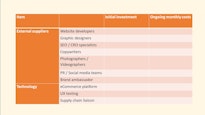How to Write an Effective Work Plan
- What Is a Work Plan?
- Who Uses a Work Plan?
- What Are the Different Types of Work Plan?
- Why Are Work Plans So Effective?
- What Should Be Included in a Work Plan?
empty
empty
empty
empty
empty
empty
- Useful Tools to Help You Make the Most Of Your Work Plan
empty
empty
empty
- How to Write Your Work Plan
empty
empty
empty
empty
empty
empty
empty
empty
empty
- Work Plan Example
- Final Thoughts
If you are working on complicated projects requiring a variety of tasks and involvement from multiple departments, then you may benefit from the creation of an effective work plan.
Similar to a to-do list, this will give you a breakdown of what needs to be done, when and by whom.
A well-written work plan will help ensure that your project remains on track and gets completed according to your estimated timescales and your budgets.
What Is a Work Plan?
A work plan will outline your key aims and objectives and provide an overview of what you are trying to achieve, breaking it down into individual goals and tasks.
When prepared correctly, a work plan can be viewed by others (outside of the project management team) to provide a clear oversight regarding the progress of your project.
It can set expectations and function as a comprehensive roadmap for your start-to-finish plan for a particular project.
Additionally, many senior management teams like to see a comprehensive work plan to aid their decision-making when signing off specific projects or campaigns.
Who Uses a Work Plan?
Work plans are effective project management tools and, as such, they can be used by a variety of people.
If you are working on a large campaign or project with multiple co-workers across different departments, a work plan can effectively aid communication and ensure that everyone knows what tasks still need to be done.
Academics often use work plans to aid their teaching schedules.
By having a clear overview of how individual elements link together, teachers and lecturers can ensure that they are cohesively covering the entirety of their syllabus.
Similarly, students can make use of work plans to ensure that their homework and their course assignments are handed in on time.
Work plans can also be used effectively by individuals, either for work-related purposes, career planning or even personal usage. You may find that your work plan is an extension of your to-do list; a plan for your working days.
Some people choose to incorporate a work plan structure to help them map out their career development.
By breaking down their ambitions into manageable goals, they can start to see what steps they need to take to progress along their preferred career path.
What Are the Different Types of Work Plan?
Work plans are subjective. Every person will use a distinct variation that suits their working style and personality type.
This is why there is a wide range of work plan templates available online. You should test and adapt them to your requirements. You may find that you prefer one style of work plan over another.
Types of work plans include:
- Individual employee work plans (similar to a well-written to-do list)
- Managerial work plans (which can incorporate personnel management as well as project overviews)
- Business development work plans (often used by business owners to assess the direction of the business)
- Timeframe work plans (which are designed to keep projects on track, and allow managers to juggle their resourcing capacity)
- Gantt chart work plans (these are handy to use if projects overlap. You can see what capabilities are available when and where)
- Mind mapping work plans (these provide a holistic overview as to how specific projects may impact a business).
Why Are Work Plans So Effective?
Simply put, work plans work because they outline all the key elements you need to remember:
- What you are trying to do
- How you plan to do it
- Who is responsible for what activity
- What the budget and timescale expectations are
- What the results are predicted to be
Work plans not only keep projects on track and ensure successful project management but they can also be used in a predictive way.
Managers can identify when they may need additional resourcing (either through traditional recruitment or through the addition of digital nomads, such as freelancers or contractors, to help as needed).
They can also analyse how the project will make an impact on the business strategy and predict when they expect a return on investment.
Furthermore, a carefully curated work plan will factor in evaluation techniques throughout the implementation. This flexibility means that you can tweak and adapt your project as you go along, giving you a greater ability to improve the impact of what you are trying to achieve.
What Should Be Included in a Work Plan?
Now that you know what a work plan is and why they are so useful, here are the details you should include within your work plan template:
Goals
First, you need to be clear on what your project is about.
By listing your primary goals, you have something tangible that you can always refer back to, ensuring that your project remains in line with what you are trying to achieve.
Where possible, try to include the context of what you are trying to achieve and why.
Measurable objectives
Once you are clear on your overall goal, you need to break these down into smaller, more achievable objectives.
You must think SMART:
- Try to think about objectives that are specific
- Identify what is measurable
- Be clear about what is achievable
- Think about what aspects are relevant to your business
- Be realistic about what can be done within the project time frame
Strategies and Tactics
This is your overview of what you are planning to do to achieve the objectives.
The strategy is the broad project/campaign aims and the tactics are the specific tasks that you will do to meet that strategy.
For example:
- Your goal may be to grow your retail business
- Your measurable objective may be to increase sales of a specific item by 30%
- Your strategy may be to improve website traffic to increase the number of users
- Your tactic is to use SEO strategies and PPC adverts to raise your profile online
Milestones
Be clear on any key milestones that you are trying to reach within the specific project.
This will help you to understand how the campaign is progressing and how much more work is needed.
Resources
It is important that you use your work plan to delegate clear responsibilities.
As well as outlining the decision-making hierarchy, you can include contingency planning here.
For example, consider who will take responsibility for the project if someone is away on paid time-off.
You can also use this section to identify when you may need to bring in additional resourcing.
There may be key elements of your project where you need to work with third-party contractors to bring in additional expertise or recruit for a short-term contract to help manage the workload.
Budget
Make sure you are clear on how much each part of the project will cost. Update your work plan as costs are confirmed.
You may find some areas are more affordable than you realize, allowing you to allocate the budget excesses to another area of the project.
You need to be prepared to manage your budgets so that you can show that you are making a return on investment.
Useful Tools to Help You Make the Most Of Your Work Plan
There are numerous resources online that can help you to develop an effective work plan template.
Gantt Charts
Tools such as Gantt Charts can be added to your work plan to showcase your timelines and resourcing.
If you are working on multiple projects simultaneously, a Gantt chart can break down the workload of individuals over many months and can provide demonstrable evidence of when and why you may need investment in additional resourcing.
Logic Network Charts
You could also use a logic network chart to demonstrate how different aspects of a project logically follow other elements.
This can help with the flow of the work plan and identify the overarching roadmap of the plan.
With a logic network, you can identify when you may expect your key milestones to appear.
PERT Chart
A PERT chart can also be used as a project (or program) evaluation and review technique (PERT).
By using arrows to visually demonstrate project progress, you can easily see how projects can get delayed or behind schedule if an element does not happen on time.
It enables more flexibility in your planning. You can incorporate contingency plans and see how different decisions lead to potentially different outcomes.
How to Write Your Work Plan
Remember, the more comprehensive you are, the more likely your projected work plan may be signed off by Generation X decision-makers, and the easier it is to use as a project management tool to keep on track.
Here is an example of how you should be writing your work plan:
Project Name, Timeline and the Purpose
If you require senior managers to sign off on the project and they want to see your work plan presented, then you need instantly convey:
- What you are trying to do
- Why you are trying to do it
- How long you think it will take
The Introduction – Expanding on the Context
At this point, you need to be clear on why you are trying to do something.
You must exactly describe the perceived issue and how you feel that this specific project is the solution.
This is important information to consider because the work plan will be a reminder of what you are trying to achieve and why. So, the project’s rationale needs to be put down in writing so it cannot be forgotten.
Identify the Goals and Objectives
As mentioned earlier, your goals should explain the specifics of what you are trying to achieve (such as increasing your retail business) and the objectives should be broken down into measurable targets.
Your objectives can be used to track your progress (for example, increasing sales of specific products or growing your social media stats).
You may wish to differentiate your goals between short-term and long-term planning.
This can help you to showcase the impact of the project on the wider business strategy, as well as demonstrate when you can expect to see an initial ROI and how this could change over time.

Timeline
This is a crucial element of your work plan. You need to be clear and realistic about how long things will take.
Not only will this be important to facilitate your resource planning, but it can also impact your budget capabilities, additional workloads and wider business strategy.
For example, if your project is about creating a new website, your business development plans may be unable to launch until the new site is ready.
Therefore, being clear on timings will help other departments assess and manage their own workstreams.
Resources and Budget
This is where you need to be open-minded.
Thoroughly consider what technology and tools you may need to complete the task.
You need to consider if you have the skills available in-house to manage key elements of your project.
If you know that you need to bring in external specialists, you will need to factor in a budget as well as time to source and procure the right people to work with your in-house team. Perhaps decide if external funding is necessary.
Remember to break down your budget, so you know how much individual components could cost.
Even minor details like printing marketing materials have costs, so be as specific as possible so you can show your senior teams that you are remaining cost-effective.
Mitigation and Contingency Planning
To ensure your project completes on time and budget, you need to carefully implement mitigation plans.
Try to anticipate what issues could arise and consider how you plan to overcome them.
For example, if you are moving to a new website, has your IT department created an online backup of your existing data? If someone is away on sick leave or taking a few days of personal leave, is there someone else who can carry on with the work, avoiding unnecessary delays?
Accountability and Responsibilities
This is where you need to be clear on what individual staff members are responsible for.
By outlining a clear chain of command, you are creating a management hierarchy that is responsible for the overall running of the project.
Accountability should be included within your work plan to ensure that each member of your team understands what role they are playing in the project.
They need to know where their responsibilities lie and how their actions can impact others.
This is where the PERT models can be effective – you can visually demonstrate how one person’s actions can impact others, improving accountability.
Strategy and Tactics
At this point, you can outline the specific actions and tasks that you are going to complete to get the project done.
This is the body of the work plan – you will be referring to this section when making sure that your project is completed on time.
Remember, your strategy is what you are going to do to achieve your objectives, and your tactics are how you are going to do it.
Be as comprehensive as possible. The more planning and preparation you do, the easier your project will be.
Evaluation
As previously mentioned, your work plan should be flexible so that you have the opportunity to adapt and change your plans as they progress.
No plan will ever be perfect from the outset, and there will always be external factors that impact what you are doing.
You need to try and factor in an ongoing evaluation plan so that you can see what is working, and where there are areas for improvement.
The more data you have of what is working well, the more you can be confident that your final project will provide an effective ROI.
Work Plan Example
To help you visualize what this could look like, here is an example of a work plan template:
Project name: Website Development Plan
Purpose: As an independent retailer, we need to explore a variety of business growth options to achieve our aim which is to be the largest provider of homewares in the region. We propose an ambitious growth plan focusing on the redevelopment of our retail website.
Timeline: We anticipate that this will take 12 months to come to fruition. This timescale includes the development of the project plan, securing the right personnel, identifying the optimum technology, migrating key data, and launching a new system that links in with our existing business infrastructure and supply chains.
We believe that there is potential to widen our scope in the local region. Shoppers are increasingly turning online which allows us to target a wider customer demographic. We believe by investing in SEO activities and turning to brand ambassadors, we can leverage a greater share of the retail market.
Goals: Our long-term goal is to be seen as the number one retailer for homewares in the State. To achieve this, we want to increase our corporate profile and develop a reputation for providing high-quality goods. In the short term, we want to see significant growth in business sales, providing additional revenue to allow us to expand into new product lines.
Objectives: To become the number one homewares seller in the city – as shown by retail sales and website traffic
- To drive interest in our homewares through an ongoing PR campaign – we want to appear in a min. 5 publications over the next 12 months
- Increase sales of our [name] range by 15% over the next six months
- Improve website traffic by 20% and use conversion rate strategies to ensure that new users are converting into paying customers
- Grow our social media following. We aim to achieve 500,000 Instagram followers by the end of the year
Timescales: We plan to launch the new retail website in October 2021. This gives us time to plan, test, and execute a new site in advance of the holiday season and allows us to tie in with Black Friday opportunities.
We anticipate up to two months to prepare a project specification and secure the right project team, a further four months for design, two months for UX testing, three months for data migration and implementation, and one month for adjustments. We recommend a period of up to 12 months for the final launch.
Please see appendix a for a Gantt chart which breaks down a comprehensive project timeline
Budget: We anticipate that we require additional investment beyond our initial departmental budget to manage the seamless overhaul of our new retail website.

Contingency planning:
- Potential issue: Data loss during the transition to the new eCommerce platform
- Mitigation: Involve the IT department to create a replica of the existing site, held securely in the cloud. To involve disaster recovery drills to ensure that data is retrievable in the event of a loss
Responsibilities: These are the individuals who will be working on the campaign and their core responsibilities
- Project lead: Jane Bloggs
- Briefing development team/point of contact for external suppliers: Jane, Jessica and Steve
- Identify new brand guidelines: David
- Secure copywriters, PR teams and photographers: Rachel
- Data research and UX testing: External team to be appointed
- SEO and PPC: Rachel
Strategy:
- To increase the website traffic by 45% over the next six months.
- To implement a cohesive and aggressive PPC campaign to improve new users and to use UX testing to retain users, and convert to paying customers
Tactics:
- To use data and CRO strategies to improve retail sales
- To implement targeted, google adverts and PPC to showcase key products (main revenue drivers)
- Work with a named brand ambassador to show how different products can be used
- Increase social media output and generate engagement with followers
Final Thoughts
Your work plan should be both an overview and an evolving document.
The work plan is something that can be used in two distinct ways:
First, as a project plan to show to management to secure sign-off and budget confirmation for a task that you want to undertake.
Second, it should also be a flexible document that allows you to see what needs to be done, who by and when.
By outlining key responsibilities and tasks, your work plan becomes a project management tool that allows you to see if you are working on time and budget.
It allows you to track your milestones and identify what is working well, and where you need to make improvements.
It should provide a clear vision of what work has already been done (and its impact), as well as what work is still needed, and how this work will directly impact your business's bottom line.
With this dual-purpose, your work plan must be written with as much detail as possible. It should be insightful enough that anyone can look at it to see what you are trying to achieve and why, as well as how you plan to get it done.
This article should give you plenty of insight into what you need to include on a work plan template, and how to write a comprehensive work plan.






